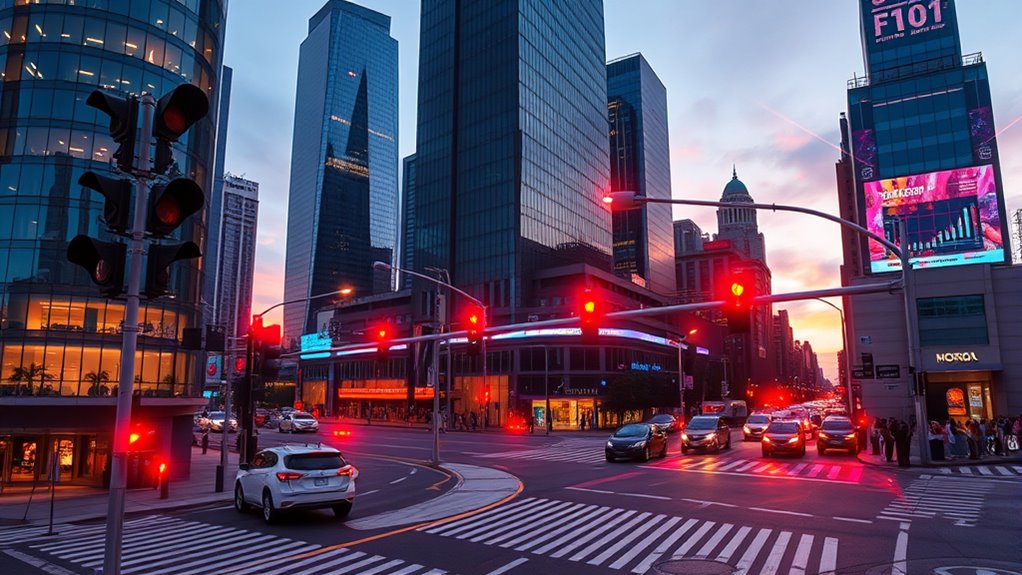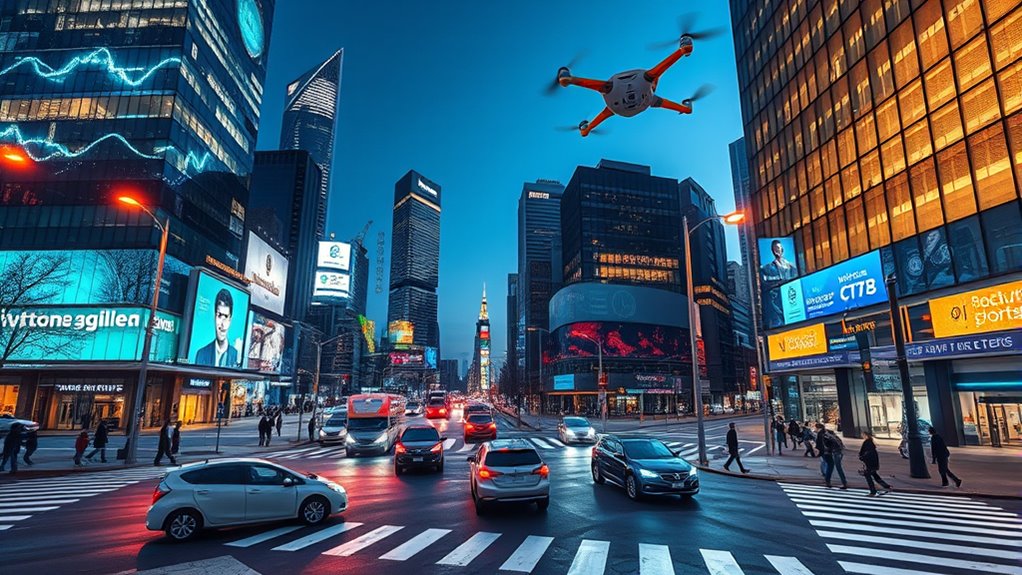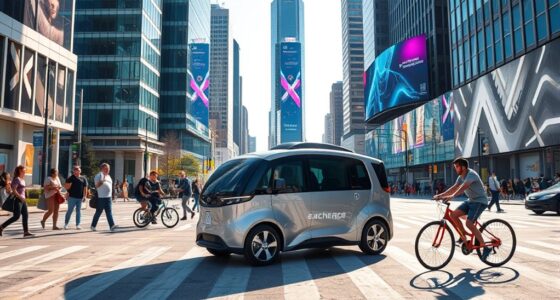Smart Cities 2.0 use AI beyond just managing traffic lights; they focus on creating sustainable, citizen-centered environments. You can expect AI systems to optimize energy use, reduce waste, and improve water management in real time. Citizen participation plays a role too, with platforms that gather feedback and data directly from residents. This combined approach guarantees urban spaces are resilient and livable. If you’re curious about how these innovations shape your city’s future, you’ll find more insights ahead.
Key Takeaways
- Smart Cities 2.0 leverage AI for comprehensive urban planning, optimizing energy, waste, and water management beyond traffic control.
- Citizen participation through digital platforms enables real-time data sharing, enhancing responsive infrastructure development.
- AI-driven insights analyze patterns in pollution and resource use, supporting sustainable urban environments.
- Immersive visualization tools engage residents in decision-making, fostering trust and community-driven solutions.
- The integrated approach creates resilient, livable cities focused on long-term environmental health and urban sustainability.

What does the future hold for urban living? As cities grow smarter, they’ll become more than just places where people live and work. They’ll transform into hubs of urban sustainability, where efficient resource management and environmental consciousness take center stage. You’ll see city infrastructure integrated with advanced AI systems that optimize energy use, waste management, and water conservation. These innovations aren’t just about technology; they’re about creating urban environments that are sustainable for generations to come. Citizen engagement plays a vital role here, too. When residents actively participate in decision-making and share feedback through digital platforms, cities can better tailor solutions to real needs. Your voice matters more than ever in shaping urban policies that promote sustainability and improve quality of life.
Smart cities empower residents through digital engagement and AI-driven sustainability for a resilient, eco-friendly urban future
In Smart Cities 2.0, AI isn’t just used for traffic lights or surveillance; it’s the backbone of all-encompassing urban planning. Imagine AI algorithms analyzing patterns in energy consumption or pollution levels, then adjusting systems in real time to reduce waste and emissions. This kind of intelligent automation helps cities meet sustainability goals while saving costs. But technology alone isn’t enough. Citizen engagement guarantees that these innovations serve the community effectively. You can be part of this process by using apps to report issues, suggest improvements, or participate in local forums. Your input helps city officials prioritize projects that align with residents’ needs, fostering a sense of shared responsibility for urban health and sustainability.
Moreover, smart cities leverage data collected from citizens to enhance urban sustainability initiatives. When you contribute data—like real-time traffic updates or environmental observations—you help create a more responsive city infrastructure. This participatory approach builds trust and accountability, encouraging more residents to get involved. As a result, city planners can implement targeted solutions that address specific challenges, whether it’s reducing urban heat islands, improving air quality, or optimizing public transportation routes. Additionally, advances in projector technology can inspire innovative ways to communicate urban planning efforts through immersive visualizations or public displays, engaging citizens even further. The combination of AI-driven insights and active citizen engagement creates a feedback loop that continually refines urban systems.
Ultimately, in Smart Cities 2.0, your role extends beyond just living in the city; you become a proactive participant in shaping its future. Through digital platforms and community involvement, you help foster urban sustainability and make your city more resilient and livable. AI optimization isn’t just about efficiency—it’s about empowering residents like you to influence how your city evolves, ensuring it remains a vibrant, sustainable place for all.
Frequently Asked Questions
How Does AI Improve Energy Efficiency in Smart City Infrastructure?
AI improves energy efficiency by optimizing renewable integration and grid management. You can depend on AI to predict energy demand accurately, enabling smarter distribution. It helps balance supply and demand, reducing waste and lowering costs. With AI, you enhance the integration of renewable sources, making the system more sustainable. This proactive approach ensures your city uses energy more effectively, reducing environmental impact while maintaining reliable power for residents and businesses.
What Privacy Concerns Arise With Ai-Driven Urban Monitoring Systems?
Privacy pitfalls pop up with AI-driven urban monitoring, raising serious surveillance concerns. As you navigate the network of sensors and systems, you must worry about data privacy—how personal information is collected, stored, and shared. These systems can lead to intrusive oversight, making you feel constantly watched. You should stay vigilant, advocating for transparent policies that protect your privacy while enabling smart city innovations to thrive.
How Do Smart City AI Systems Adapt to Unforeseen Events?
You can see how smart city AI systems adapt to unforeseen events through their adaptive resilience. They analyze real-time data to detect anomalies, predict impacts, and adjust operations quickly. During emergencies, these systems enhance emergency response by rerouting traffic, activating alerts, and deploying resources efficiently. This proactive approach helps cities respond faster, minimize disruptions, and maintain safety, making urban environments more resilient and better prepared for unexpected challenges.
What Role Does Citizen Feedback Play in AI City Planning?
Think of citizen feedback as the heartbeat of urban governance. You play a essential role in shaping AI city planning by sharing your experiences and insights through public engagement. Your input acts as a compass, guiding city officials to prioritize what truly matters. This ongoing dialogue ensures that AI systems adapt to your needs, making cities smarter, more responsive, and ultimately, more livable for everyone.
How Are AI Algorithms Protected Against Cyberattacks in Smart Cities?
You should understand that AI algorithms in smart cities are protected through strong cybersecurity measures, including advanced encryption protocols. These protocols secure data transmission and prevent unauthorized access, ensuring system integrity. Regular updates and intrusion detection systems help identify and mitigate cyber threats quickly. By implementing these security practices, smart city infrastructure stays resilient against cyberattacks, safeguarding sensitive information and maintaining smooth AI operations.
Conclusion
Imagine a city where AI seamlessly orchestrates traffic flow, energy use, and even waste management, turning chaos into harmony. Streets flow smoothly, neon lights pulse in sync with the rhythm of life, and you feel the pulse of a truly intelligent metropolis. Smart Cities 2.0 isn’t just a vision; it’s a vivid reality waiting to unfold. As you walk through this future, you’ll see a world where technology and life blend effortlessly, creating a smarter, more vibrant tomorrow.









